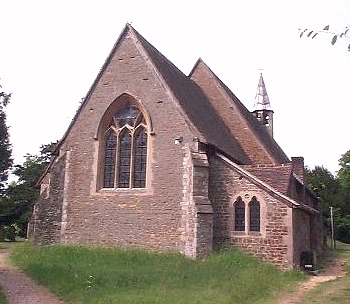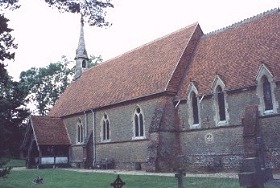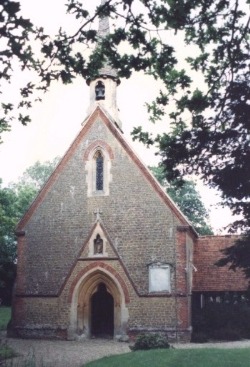- Henry Woodyer
- (1816 - 1896)
The eminent Victorian architect, Henry Woodyer, had strong family and
professional links with the village of Normandy. He was born in 1816 at
Allen House, Guildford, the son of Caleb Woodyer a surgeon of Guildford
and his wife Mary Anne Eleanor - a daughter of Henry Halsey the owner of
Henley Park, Normandy. Henry had two sisters; Mary Ann who married Lannoy
Arthur Coussmaker of Westwood, Normandy and Elizabeth who married her first
cousin, the Reverend William Elliott, Rector of Cresting, Suffolk - a grandson
of Henry Halsey.
Henry was educated at Eton and later at Merton College, Oxford where
he matriculated in 1835 receiving his BA degree in 1838. Apparently, at
that stage he was still undecided as to what career to take up and even
considered entering the Church. However, from Oxford, he entered the office
of William Butterfield, one of the leading architects of the Gothic Revival.
An early commission for Henry was the restoration of St Nicholas Church
Compton in 1843.
He began to practise independently in 1846, working mainly in Surrey
and Berkshire, operating from 108 High Street, Guildford, the same address
as his father's surgery, but continuing to reside at Allen House until
his marriage in 1851 to Frances Martha Bowles. In 1846 he designed the
National Schools at Ripley and in 1847 he carried out his first complete
church commission for his brother-in-law Lannoy Arthur Coussmaker of Westwood,
when he designed St. Mark's Church, Wyke, in the parish of Ash. In 1955
Wyke became part of the parish of Normandy.
 |
- St. Mark's Church,
- Wyke from the East
|
Henry's father died in 1849 leaving him properties in Stoke and Guildford,
enabling him to be financially independent to continue his chosen career.
Sadly, his wife Frances died in 1852, (the year following their marriage)
and so soon after giving birth to their only child, Hester Fanny, born
that year.
Frances was buried at Milton in Berkshire, where Henry was restoring
the parish church. He returned to Surrey with Hester to pick up the threads
of his life and in 1854 bought Grafham Farm, Grafham a few miles south
of Guildford, just off what is now the A281 Horsham Road. Later, he turned
the original farmhouse into a substantial Country House and renamed it
Grafham Grange.
| In 1864 he designed and built as a memorial to his late wife and at
his own expense, the church of St. Andrew, Grafham. Henry was determined
to have a screen in his church but the Bishop Henry Sumner of Winchester
detested screens in churches, considering them to be a sign of Popery.
Henry had designed his screen as an integral part of the structure and
claimed that the church would fall down if it was removed. Needless to
say; Henry got his way.

- St Andrew, Grafham From the southeast
|

- St Andrew, Grafham From the west
|
He continued to design and restore churches (at no great expense to
his clients), for the rest of his career, also designing and altering private
houses and schools. Among many such commissions, he rebuilt the East Wing
of Wotton House near Dorking for the Evelyn family and in 1860, designed
Cranleigh School, which today is a renowned academically famous Public
School. In addition, he designed church furniture, ironwork and fittings
and his builders were almost exclusively Wheeler Brothers of Reading although
commissioned ironwork was generally from a Guildford firm.
At Meads, Eastbourne, East Sussex can be found the magnificent All Saints
Convalescent Hospital (the foundation stone for which was laid in 1867),
and close by its equally spectacular chapel, both buildings designed by
him, in his typical version of the Gothic Revival style - built primarily
of brick with Bath-stone dressings and Forest of Dean stone for the steps
of staircases and window shafts. The hospital was declared open on the
19th July, 1869, followed a little later with the chapel.
Probably, his greatest achievement and grandest church is that of St.
Martin, Dorking (completed in 1873), that still dominates the old town
in the Mole Valley and serves as a fine example of Victorian Gothic workmanship
to this day.
His daughter Hester, who had been his constant companion for some 39
years, married in 1891 Lieutenant General Sir Percy Lake and shortly afterwards
she and Sir Percy emigrated for Canada.
Henry never re-married after the death of his wife. He sold Grafham
Grange and moved to the village of Padworth in Berkshire where he died
in 1896. In accordance with his wishes his body was brought back to Grafham
and was buried in the churchyard of his beloved St Andrews church.
Woodyer's luxuries in life were his lovely garden at Grafham and his
steam yacht, "Queen Mab", in which he cruised in the Mediterranean.
He was not particularly skilled as a draughtsman and his handwriting was
almost indecipherable. He kept a small staff of elderly assistants at Grafham.
Part of the range of buildings enclosing a courtyard included offices where
his assistants worked.
No portrait of Henry Woodyer has been found, but he is remembered as
a tall, distinguished-looking man with a full beard and moustache. He wore
a wide-brimmed hat and donned a long dark Inverness cloak in bad weather.
His appearance would have resembled that of the outdoor portraits of Alfred,
Lord Tennyson.
Jack Kinder
References:
A Breath of Heaven , All Saints Convalescent Hospital,
Eastbourne 1869-1959 by Kay Syrad, 2002.
A lecture on Henry Woodyer at Guildford Civic Hall on 6th October 1994.
Famous Surrey Architects No.5, Surrey County Magazine, 1979.
Short Dictionary of British Architects by Dora Ware, Allen and Unwin, 1967
The Story of Grafham Grange by D C Gasney, 1962
The Woodyers, Father and Son from Allen House, Some Notes on its History
by D M Stanley, 1963.
- Wikipedia links
- Henry
Woodyer
|